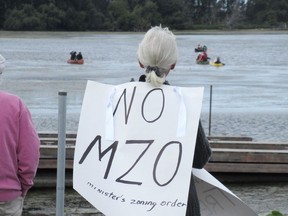Kingston city council votes against development on former Davis Tannery site

Article content
KINGSTON — City council followed the planning committee’s lead and rejected the redevelopment plan for the former Davis Tannery property.
In an 8-5 vote Tuesday night, city councillors voted down official plan and zoning bylaw amendments that the “complex and contentious” project needed to proceed.
Kathleen O’Hara of No Clearcuts Kingston, a group founded last year in opposition to the project, called the decision a “win for nature and citizen engagement.”
“We’re facing an increasingly deadly climate crisis, so we can no longer treat trees and wetlands — and the wildlife they support — as if they don’t count,” O’Hara said in an email. “We can also no longer treat citizens as if their opinions aren’t as important as business and other powerful interests.”
The tannery decision was likely the most contentious of this term of council, dividing councillors into those who prioritized protecting the trees on the property and those who wanted to add 1,600 housing units to the city centre.
“I don’t think I have lost more sleep on any file than the tannery,” Trillium District Coun. Robert Kiley, chair of the planning committee and one of the five councillors who supported the proposal, said.
The planning committee rejected the tannery applications in early August.
In the end Tuesday, the decision was partly framed by what expert opinions councillors were more comfortable believing. In the hours leading up to the meeting, councillors received hundreds of emails from residents, almost all of them opposed to the development.
“Do we trust the collective expertise of our constituents, do we choose to support our constituents or do we support the developer who has so much to gain in this proposal?” Williamsville District Coun. Jim Neill, who voted against the proposal, asked.
The lack of a detailed remediation plan from the developer was cited by many councillors opposed to the applications.
In addition to a remediation plan, the city needed to see an independent hydrology report and input from an environmental lawyer before the development could go ahead, Portsmouth District Coun. Bridget Doherty said.
“We treated it like any other brownfield site, but it isn’t,” Doherty said, adding that the type of contaminants on the property and their proximity to the Cataraqui River pose risks that need to be mitigated.
Developer Jay Patry’s proposal called for the cutting down of about 1,600 trees and remove about 400,000 tonnes of contaminated soil followed by the construction of four buildings containing about 1,600 residential units, 3,600 square metres of commercial space and 6,000 square metres of “flex” space that could be used for commercial or residential, depending on market demand.
Once the development was built in about 12 years, it would include 100 affordable units.
“That is weak,” Sydenham District Coun. Peter Stroud said. “I don’t think it is going to move the needle on rents.
“This proposal is not to our standard.”
In addition to rejecting the amendment applications, the planning committee also rejected a staff recommendation to seek a ministerial zoning order (MZO) for the fourth phase of the development and the property containing a provincially significant wetland.The MZO could be needed because provincial legislation prohibits cleanup and redevelopment of former industrial sites located in provincially significant wetlands.
Collins-Bayridge District Coun. Lisa Osanic said such a move would set a precedent that other developers could use to put forward projects that damage the environment.
“That is not a reputation I want Kingston to have,” Osanic said.
“We could be setting a precedent for the province, especially if we use an MZO,” Kings Town District Coun. Rob Hutchison said. “That, I think, is environmentally dangerous.”
Among the correspondence councillors received was an email from resident Douglas Perkins, who crunched the numbers and estimated that removing 400,000 tons of contaminated soil from the site would require almost 12,000 dump truck trips on city streets. Just as many truck loads of clean fill would be needed to replace the soil that is removed, Perkins wrote.
Loyalist-Cataraqui District Coun. Simon Chapelle, who grew up in Sudbury where heavy trucks working were a common sight on city streets, said those trucks would damage the local road network.
“If you want to see what roads look like in Sudbury, just drive down Johnson Street,” Chapelle said.
Rejecting the tannery proposal will make it difficult for councillors to say housing availability and affordability is the city’s top priority, Mayor Bryan Paterson said.
“If we say no to this, then we are going to have to cut down trees elsewhere,” Paterson said. “We can’t say housing is a priority and say no to a project like this.”
Paterson said rejecting the “once-in-a-generation opportunity” to redevelop the tannery site will increase pressure on the city to expand the urban boundary, something city council has previously resisted.
Send us opinions, comments and other feedback. Letters may be emailed to whig.local@sunmedia.ca. Letters to the editor must contain the writer’s name, address and contact information. The Whig-Standard reserves the right to edit, shorten or reject letters.”
